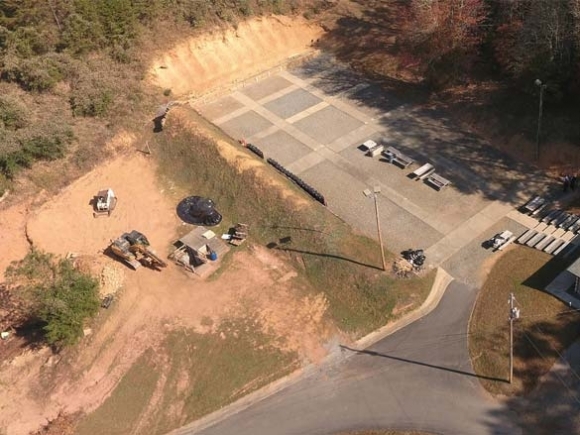Shooting range sound spurs complaint

Located behind the Tuckaseigee Water and Sewer Authority treatment plant off North River Road, Southwestern Community College’s shooting range is the go-to training ground for law enforcement officers across the region.
But lately people living around the range have been complaining about the noise produced when thousands of rounds are fired in a single day.
“They all say to me, ‘Close the range,’” said Commission Chairman Brian McMahan, referring to the unsigned text messages he’s been receiving on the subject. One neighbor also met with him in person.
Commissioners and SCC officials met during a Nov. 14 commissioners work session to discuss the issue, but McMahan and his fellow board members made it clear that the discussion was about sound abatement only — shutting down the range is not an option.
“We live in a very troubling time,” McMahan said. “A little more than a week ago, a deranged psychotic person walked into a church in Texas and massacred 26 people, some of them little kids. That’s the world we live in unfortunately, and these guys in law enforcement have to face that every single day. That could be right here in Jackson County, and I support our law enforcement 100 percent. They need a place to train, and as far as I am concerned I am not in favor of shutting the range down.”
In a follow-up interview, McMahan said that he’s “not trying to be insensitive to the noise” and wants to see the county, which owns the property and leases it to SCC, “be good neighbors and do what we can to build new sound buffers.” However, he pointed out, most if not all of the people complaining moved to the area knowing that an active shooting range was in the neighborhood.
Related Items
“Let’s not look at shutting it down, period. That’s not an option, but look at how can we keep the quality that we’ve got, but also is there means or measures that we can do to maybe become a better neighbor,” said Commissioner Mickey Luker at the Nov. 14 meeting.
While Commissioner Boyce Deitz also stated he would not support shutting the range down, he expressed strong sympathy with those who have to hear the shooting day in and day out.
“I think we at least need to be sensitive,” he said. “I have a neighbor who lives in Nashville, Tennessee, and he comes home about every two months. I know when he’s home because we’ll be sitting there eating supper and it’s bam-bam-bam-bam for an hour, and it’s not pleasant.”
Options for abatement
While commissioners agree that the county should do something about the noise, what exactly that something will be remains to be seen.
Marc Boberg, SCC’s director of facility services and operations, presented a variety of options during the Nov. 14 meeting, ranging from installing suppressors on weapons to building a roof to contain the sound. Each option would have a different impact on noise level, officer training and budget.
Shooting ranges produce noise in two ways, Boberg explained. There’s the sound that occurs when the bullet fires, and the one that happens when it hits its target. Different mitigation techniques would address different noise sources.
“Because of the distances they happen very quickly, so you may not be able to distinguish between the two,” he said.
To attack sound emanating from the gun itself, suppressors would be the obvious choice. But that’s not likely to be a good fit for this situation. Suppressors increase wear and tear on the gun, meaning that each training weapon would have a shorter useful life; they also take away from the real-world understanding officers are supposed to derive from their training.
“You do on the range what you may have to do in real life,” McMahan said. “So the last thing we want is people trying to put suppressors on and doing all the stuff that isn’t natural and is something they wouldn’t be doing in the course of duty on an average day.”
The other end of the spectrum would be constructing a roof over the shooting range to keep sound waves more contained. Such construction would likely have a significant impact on the noise level near the range, but it would also be the most expensive of the options available.
In discussion, some commissioners seemed to favor exploring a combination of less intensive mitigation options. Installing a higher berm around the range’s perimeter, Boberg said, could have a significant impact. The existing berm is pretty small, about 6 or 7 feet from the 25-meter firing line with no berm at the 50-meter line. Building that berm higher could go a long way toward breaking up sound waves.
Planting trees on top of the berm, Boberg said, would reduce the noise even more. By combining those measures with a new lead catcher, made of a material that would produce a softer sound on impact than the one currently in place, the sound level would go down significantly.
“In most cases, those systems will reduce it 20, 25, 30 percent, depending on angles and where you’re at,” he said. “It really does depend on what direction you’re at versus the firing line.”
If those measures don’t reduce the sound enough, he said, there are other options. A baffling system, soundproof walls like those installed along interstate highways and roofing are all possibilities. However, those would all be significantly more costly than building up the berms, planting trees and replacing the lead catcher, and it would be important to design such structures in a way that doesn’t take away from what the shooting range is there to accomplish.
“If you start putting pillars in the middle of the range, it then limits the ability to do the training they have been doing,” Boberg said. And if the installation were to reduce the number of lanes available, trainees would need to shoot longer into the night to get the same job done.
An ongoing discussion
During the Nov. 14 meeting, McMahan encouraged SCC to put together its preferred plan for mitigation, which could then be discussed with commissioners, and County Manager Don Adams suggested that the county plan for a phased approach — installing the berm, trees and new trap now, for example, and outlining a phase two plan if that doesn’t work.
“I would think that what we’d probably want to do is start with the minimal first,” McMahan agreed in a follow-up interview. “Let’s go in and reconstruct the berm, make sure the berm is like it’s supposed to be, plant some shrubbery and trees, maybe then consider putting in that backstop. Those things alone might make a huge difference.”
Commissioner Ron Mau, meanwhile, was a bit more skeptical about the potential impact of those measures. He’s heard that roofs and baffles work very well, and while he understands that approach might end up being too expensive, he’s interested in visiting an existing structure to see how well it works.
“I guess I have my doubts about the vegetation option,” he said in a follow-up interview. “Just how much does it abate the sound if you plant more trees and raise the berms?”
Mau looks forward to getting some cost estimates for each of the possible options and exploring whether any grant funding might be available.
Any mitigation would be funded through next year’s budget, beginning July 1. Commissioners typically begin budget planning in January, so it’s unlikely any particulars will be nailed down until late winter or early spring.
Lead remediation wrapping up
The shooting range at Southwestern Community College has been in the news quite a bit over the past few years, but not because of noise.
In 2014, testing revealed that accumulated lead deposits from continuous shooting over the years had resulted in substantial contamination of soil on the range. The discovery resulted in multiple rounds of testing, studies and discussions as to what should be done to rectify the situation.
However, it appears that SCC is now on the tail end of dealing with those issues. In 2016, SCC paid the contractor Containment Control, Inc., $171,400 to remove, treat and dispose of 350 tons of contaminated soil at the site.
In May, four monitoring wells were installed to find out whether lead contamination was affecting the groundwater, and by extension the nearby Tuckasegee River. Three of the monitoring wells, which cost about $14,000 to install, did not detect any lead at all, while the fourth was “well within the state standards,” according to a May 12 email from Marc Boberg, the college’s director of facilities services and operations. None of the wells detected polycyclic aromatic hydrocarbons.
The college still has to install a soil cap and build a sediment pond but is waiting on final recommendations from the N.C. Department of Environmental Quality to move forward. Once the DEQ approves a final solution, SCC will present the plan to county commissioners.









